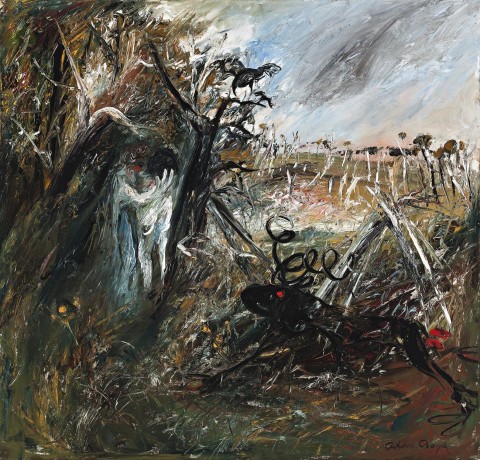LOVERS AND BEAST IN A FOREST, 1966
ARTHUR BOYD
oil on canvas
108.5 x 113.5 cm
signed lower right: Arthur Boyd
Barry Stern Gallery, Sydney
Private collection, Sydney, acquired from the above in 1969
Philipp, F., Arthur Boyd, Thames and Hudson, London, 1967, cat. 17-24, p. 227
Encapsulating the heroic and poetic in an Antipodean tragedy of thwarted lovers, Arthur Boyd’s ‘Love, Death and Marriage of a Half-Caste’ series 1954 – 59 is universally considered among his finest. Thus, upon his arrival in London shortly after the completion of the landmark series which had won him so much acclaim, Boyd did not immediately abandon this hauntingly beautiful theme, but rather began to expand its imagery further – transforming the poignant narrative into more general meditations upon the destinies of Eros and the mythology of desire. Profoundly influenced by the great masterpieces of Renaissance art which were now so readily accessible in the vast museum collections of Europe, Boyd was attracted in particular to the work of fifteenth-century painter, Piero di Cosimo with his famous painting, A Mythological Subject in the National Gallery, London, leaving a particularly indelible impression. Unlike Titian, Tintoretto and Rembrandt, di Cosimo was not considered one of the masters of his time, but rather its unicum; ‘he loved to see everything wild’ wrote Vasari and accordingly, his most memorable work explores the development of man from animal state to early civilisation.1 Consciously or otherwise, it was this streak of primitivism and the slightly macabre association of eroticism and death by the Renaissance artist that would inexorably pervade Boyd’s images of love for decades to come.
Upon first glance, the present Lovers and Beast in a Forest, 1966 bears echoes of Boyd’s Angel Spying on Adam and Eve, 1947 – 48 with the two lovers embracing furtively behind a tree in the woods, accompanied by the signature Boydian motif of the black ram. However, if playing a passive, almost protective role in the earlier composition, here the horned beast is decidedly more active, aggressively charging the couple and thus, evoking unmistakable allusions to the nature of sexuality in the vein of Boyd’s sensuous mythological tableaux from the same decade – for example, the ‘Nude with Beast’ series inspired by Titian’s The Death of Actaeon (National Gallery, London). Significantly, Lovers and Beast in a Forest is also distinguished from Boyd’s work prior to the 1960s by a more sophisticated painterly technique in which the relative flatness of the picture surface is exchanged for a heavier impasto style featuring thick streaks of paint carefully worked with a knife or brush handle akin to the vigor of expressionism. While no doubt deriving its impetus from the Antipodean artist’s first-hand experience of viewing works by Tintoretto and Rembrandt, such stylistic transition arguably carries powerful iconographic implications as well. Not only do the united lovers here seemingly merge into a ‘joined figure’ suggestive of the ‘oneness’ of the Platonic myth, and possibly even extending to notions of fertility-death or Narcissistic doom, as contemplated by Boyd elsewhere. Moreover, such ‘effacement’ continues between the two figures and the ground; the enclosing, darkly glutinous forest appears at once threatening and embracing, perhaps implying the re-entering of an eternal cycle of Nature.
1. Hoff, U., The Art of Arthur Boyd, Andre Deutsch, London, 1986, p.53
VERONICA ANGELATOS
